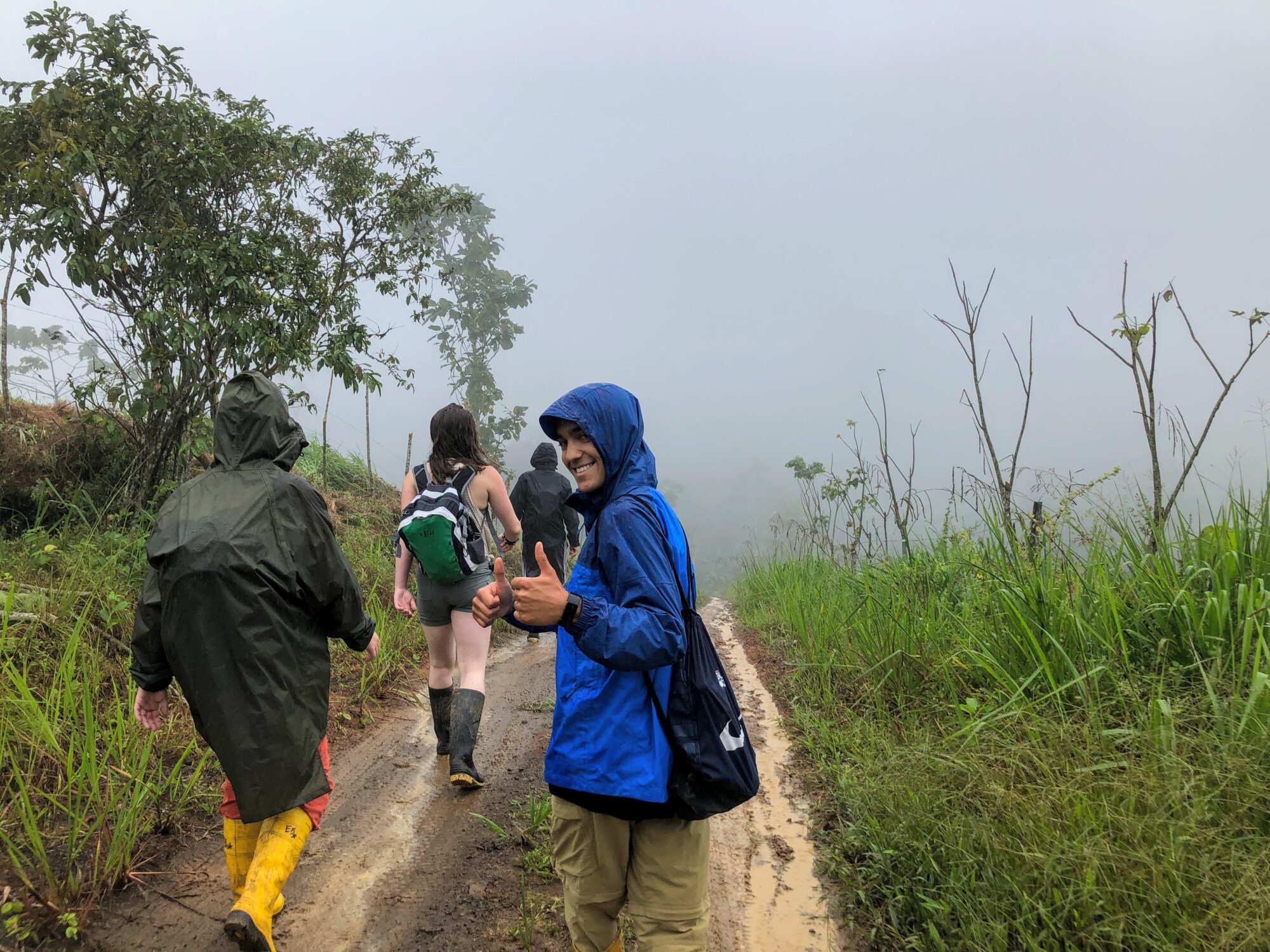Changemaker Catalyst Award recipient, Jack Cohn, traveled to the Chocó Rainforest in Northwest Ecuador in June 2022 to research the ecological interactions between seed-dispersers and fruiting palm trees. Jack is a junior, class of 2024, majoring in Environmental Biology.
This past summer, I participated in my first ever extended independent research abroad, opening my eyes to what goes into scientific fieldwork among researchers. My goal was to study seed dispersal among palm trees in a tropical environment; more specifically, I wanted to focus on secondary seed dispersal, when animals disperse seeds after falling from the focal tree. Secondary seed dispersal is crucial to conservation, allowing trees to pass their seeds distances otherwise impossible, giving their species the greatest chance of survival.
After traveling in a van for five hours from Quito, other researchers and I transferred our belongings to trucks, where we spent another couple of hours on rural dirt roads before arriving at the remote FCAT field station.
The FCAT station is home to local workers employed full-time, part-time workers, and kitchen/cleaning staff (called FCATeros). Researchers from numerous institutions come here to study in a pristine tropical environment. I was eager to learn from the various researchers and begin my research with the help of Tulane master’s student Vishal Narayan. Arriving, we had a good idea of what our experiments would entail. We would set up fruit caches at the bases of palm trees in different environments to simulate the dropping, then come back after a few days to check on their interaction rate with frugivores (fruit-eaters). Easy, right? So we thought.
It didn’t take long to figure out that we needed to adapt our project. The species we intended to study was not fruiting when we were there, so we had to pivot to another palm species. We then discovered that the plots we planned to conduct our experiments had not been mapped fully, meaning only the canopy palms were recorded. Our species was an understory palm. There was only one logical solution: GPS and identify every single understory palm in the plots where the canopy palms were recorded to get a complete picture of the densities.
The jungle had innumerable daily obstacles, such as vines, snakes, bullet ants, and holes to traverse
This meant trekking through dense jungle for hours, slogging through mud, clay, and vines to locate and GPS the palm trees. I owe all the credit to the local FCATeros for being able to scan the jungle for palm trees and GPS them for us.
Field notebook containing information on palm species, GPS coordinates, and phenology
In the end, we counted over 700 palm trees belonging to 8 species. However, what I thought would be tedious work revealed some of my experience’s best moments. Between falling on vines and slipping down muddy slopes, the jungle gave us the freedom to talk freely with each other, whether that was about past experiences, future goals, family histories, or anything else. We played music from our phones, chatted with the FCATeros (consisting of a lot of “Spanglish”), and enjoyed each other’s company, learning from each other and figuring it out as we went.
While most of our days consisted of fieldwork, we did get a few days off. We would go into town, go to a swimming hole, or hang around the field station playing cards or Chess. I learned from researchers from numerous institutions, such as UC Santa Barbara, Ohio State, and Tulane. The research topics ranged from fungal interactions in the soil to bird reproduction and everything in between. I was thrilled to learn from experienced scientists, hearing about their struggles and often unconventional routes to scientific research. Not only is fieldwork physically intense, but it also requires being away for extended periods, often in remote areas with limited cellular service. Not only does this need deep intrinsic motivation, but it requires an ability to move past self-doubt and independently work to find solutions when things don’t go according to plan.
A crucial aspect of the FCAT station is its commitment to working with local communities to produce community-based research. Hiring locals who know the land better than any foreign researchers gives them influence in our work and a sense of pride in where they grew up. Despite the language barrier, the FCATeros were patient and always willing to communicate and help us with our research. They pointed out unique flora and fauna, shared their own life stories with us, and truly became something more than just colleagues; they became friends.
The FCATeros showed us incredible wildlife while keeping us safe from venomous snakes and other dangers.
I learned a lot about myself and my future goals as a researcher while in Ecuador. Fieldwork is not all fun and games; it’s just as mentally challenging as it is physically. It requires introspection and overcoming self-doubt. Being in an isolated field station also required patience and the ability to work with people of all different backgrounds and interests, from local researchers, PhDs, or undergraduates.
As I look to the future, I am confident the FCATeros will be able to continue the experiments we began until the fruiting season is over. I’m excited to examine the results of our hard work and help the scientific community further understand how animals disperse seeds within tropical environments. I’m thankful to everyone at FCAT for making this experience possible, the Cocineras, FCATeros, and my fellow researchers. I’m also grateful that FCAT would like to have me back to continue my research in the future.
I look forward to expanding on this experience and applying my education in Environmental Biology to solving real-world problems.






